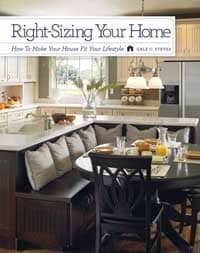
A new book helping consumers “Right-Size” their homes to live more efficiently and comfortably provides prudent marketing insights for frustrated furniture retailers seeking new ways to escape the costly activity trap of price advertising.
“Right-Sizing Your Home,” author and former editor in chief of Home Magazine Gale Steves challenges people who have decided to stay in their homes, and assess how they really use their interiors to achieve their homes’ highest and best purpose of comfortable and efficient living.
“In this economy, it’s the same for retailers struggling to attract and sustain business in solid ways that are consistent with changing lifestyles and attitudes,” she said, challenging merchants and the industry to think like “millions of people who choose for practical or economic reasons to remain in their homes. This is retail opportunity because the people staying put are more receptive to improving their homes as an investment for better living.”
The “improve-no move” reality establishes a right-sizing premise for retailers “who can benefit from rethinking how they reposition their businesses as trusted problem solvers for people whose houses, apartments and condominiums evolved into more than homes.
“Here is a potentially great opportunity for retailers to right-size their businesses to escape the profit-sapping activity trap of price-driven promotion and move onto the accomplishment map of greater credibility,” Steves said. “Stressing right-sizing, retailers are recognizing the evolving role and function of homes by their varied yet interrelated use: lodging, eating, teaching-learning, storing, entertaining, rehabilitating, relaxing, creating and more.”
She emphasized that “insufficient and potentially alienating” retail marketing strategies that push price ignore crucial lifestyle needs of people wanting bona fide guidance to solve their space and living problems.
“Right-sizing-minded retailers project deep insight into the needs of people, with ‘we-can-help-you-live-better’ marketing and merchandising messages that can resonate,” Steves said. “
The more retailers can help people repurpose their homes according to a “pent up” desire to live more functionally, efficiently and comfortably, the greater the opportunity to drive more loyal business. The reason is consumers view the right-sizing retailer as a credible resource instead of me-too store only motivated to sell furniture any way possible without regard to consumer needs, she explained.
Steves learned about the pent up consumer desire in April when a story about right-sizing in the News & Record of Greensboro inadvertently reported her Spring Market “lunch n’ learn” seminar was open to the public.
“To my surprise and delight this spring, more than 400 people responded to the High Point Market Authority, sponsor of the seminar, wanting to attend,” she said. “That kind of response told me that many people want to learn about ways to right-size their homes.”
For the Fall High Point Market in October, Steves is developing an expanded seminar on right-sizing.
For retailers, a right-sizing merchandising focus helps convey an engaging perspective that empowers in-store designers and counselors with a non-threatening tact, encouraging customers to assess how they live and use rooms. “If anything, right-sizing is a form of efficient home-staging that helps resell the house’s potential to existing occupants,” she said. “That kind of fresh perspective is exciting to homeowners and good news for the industry.”
Steves argues that right-sizing transforms passé price marketing into a credible emotional appeal that connects with people wanting to learn how to live better. What’s more, it assumes consumers will respond more positively to retailers whose aspirational marketing allays their fears about making costly mistakes with infrequently home furnishings.
“Imagine the success of a designer whose respective, yet perceptive probing helps a potential client recognize that a rarely used dining room could have another more functional purpose,” Steves said. “That under used dining room could be a fresh home office or a hobby area for multi-functional family balancing needs of children and enterprising adults.”
The book can serve retailers as a validating tool, helping to establish a prudent path to giving home interiors a new face for better living. “Mine the book for nuggets of merchandising gold,” she said.
In researching the book, Steves interviewed more than 300 persons, asking a host of questions, revolving around how they used rooms. Everyone said that they needed more storage space, no matter what the size of their home, but when queried further, they admitted that they formerly moved to another home or added onto their existing home, instead of facing the problems of “right-sizing”
“Right-sizing merchandising is almost a no-brainer for retailers. Create a place in the store for highly functional furniture, pieces that the ‘improve-not move’ home owners recognizes as a solution to their problems and needs,” Steves said, suggesting that right-sizing is a relationship-building marketing concept.
“In this economy, money is tight, and that means people will be buying pieces, hopefully, more often from retailers who cultivate the business with marketing strategies and tactics appealing to needs based on dreams, wishes and aspiration for a comfortable home,” she said.
Right-sizing is not downsizing. The book advocates developing smart attitudes about using space as effectively as possible, according to need. As the book’s title declares, right-sizing is a process helping people comprehend the size and scale of their interiors, to preclude the frustrating and costly error of wrong-sizing, usually too large, sofas, tables and storage pieces that cannot fit in rooms, let alone elevators and up stairwells.
“No one wants returns, especially retailers,” Steves said. “That’s why Chapter 2 suggests the importance of creating a living floor plan, using grocery-bag brown paper to construct furniture models.”